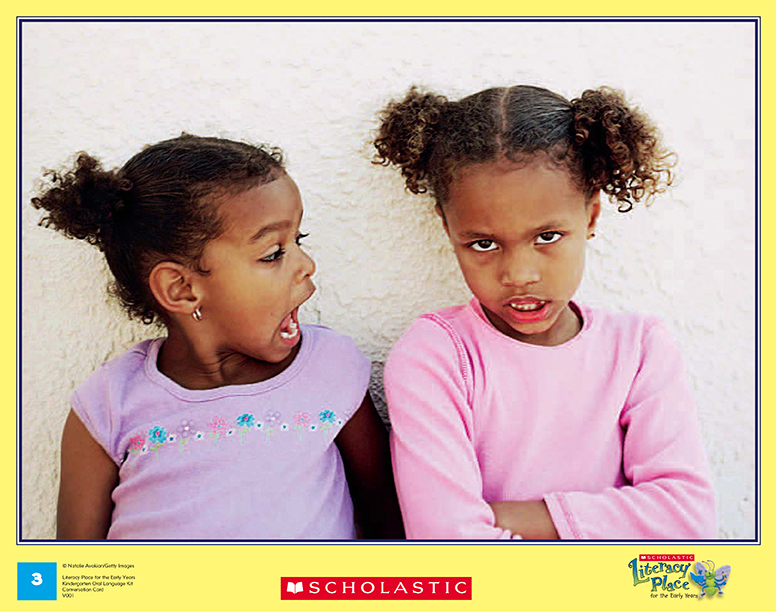Role-Play – Explore Other People’s Viewpoints Use role-playing to stimulate social language development and problem solving.
Time: one 30-minute lesson or two 15-minute lessons
Materials: Emotions/Interactions Card #3
Grouping: whole class or small group
Assessment: Kindergarten Oral Language Assessment Scale
FOCUSING ON THE PICTURE
-
What do you think the girls in this picture are doing?
Show students the picture and ask them to think about what they see and what they think is happening.
- Invite each student to share their ideas about the picture with a partner.
- Provide time for partner discussion and then invite a few partners to share their thinking with the group.
[Analyzing/inferring]
- Offer prompts to stimulate discussion:
- Who are the people in this picture? Let’s give them names.
When you look at a picture for the first time, what are some of the things you wonder about?
Where do you think they are?- What do you think is happening? Why do you think that?
- We don’t know exactly what is happening, but it is okay to suggest different things that make sense and fit the picture.
GOING DEEPER
[Inferring/evaluating]- Offer prompts that focus the students on the emotions and interaction portrayed:
- How is each of the girls feeling? Why do you think that?
- Why do you think one girl is crossing her arms?
- What do you think the other girl is saying? How is she saying it, for example, gently, angrily, or cheerfully? Why do you think this?
-
I’m going to pretend to be the girl who is talking in the picture and say, “I’m scared of dogs and there’s one coming towards us!” You pretend to be the other girl. What would you say? How would you say it? What kind of voice would you say it with?
If the girls were in a different place do you think the interaction between them would be the same or different? Why?
- Role-play the interaction by taking the part of one girl and inviting students to take on the role of the other girl.
- Once you have practised taking parts together, ask students to role-play with a partner some possible conversations between the two girls.
Teaching Tip: If you do this role-play early in the year, you may decide to take the role of one person and invite the class/group to share ideas about what the other person would say. Once you have practised this type of supportive role playing several times, have students try partner role-playing.
You may conclude the lesson at this point and do the second part on the next day, or you may decide to continue and do Connecting and Predicting as part of the first lesson.
CONNECTING
Teaching Tip: If you decide to do Connecting and Predicting on the second day, begin your lesson by reviewing the picture with the students.
[Making connections]- To prompt students to connect their personal experiences with the emotions and interactions in the picture ask:
- Have you ever felt the same as one or both of these girls? What was it that made you feel like that?
- How do you let someone know how you are feeling in a situation like the one in this photograph?
- How do others help you when you are feeling like either girl in the photograph?
-
When your friend spoke loudly to you how did you feel? What did you do?
Offer specific prompts that fit the discussion you have had with the group
PREDICTING
[Predicting]- Ask students to think about what may have happened just before this photograph was taken.
- What do you think happened before this picture?
- What makes you think that?
-
Whenever I look at a photograph I try to imagine what happend just before the picture was taken. I like to make up a story in my head what I think happened.
What do you think the girls are going to do next?
- Together as a group, create a story and invite partners to act it out.
LESSON EXTENSIONS
-
Using the picture as a starting point, brainstorm as a group what may have happened before the scene and after the scene in a 3-column chart labelled ‘Before,’ ‘During,’ and ‘After.’ In the ‘During’ column, post the photo. You can return to this chart later to do a shared writing lesson. Or you can post the chart at a centre and invite students to role-play some of the scenarios you created as a group.
-
Use the shared writing as a shared reading text and reread with the students.
-
Provide a copy of the shared writing text in the reading centre so students can return to it at a later time.
FOLLOW-UP IN CENTRES
-
Invite students to create and role-play a story that uses the photograph as the beginning, middle, or end of their story. They may choose to be the characters or to use puppets for the role-playing.
-
At the art centre have students paint a picture that shows what they think happened before or after the scene in the photograph. Have students explain their painting.

